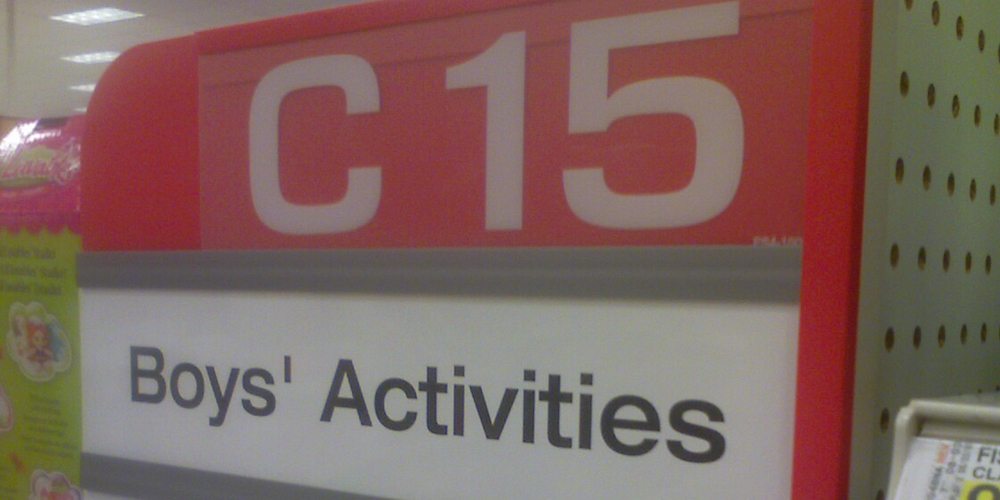
Target recently made the announcement that they are going to try and reduce the instances of gender-directive signage in their stores, in places like the toy aisles and kids’ bedding, where such classifications aren’t really needed. From their statement:
Over the past year, guests have raised important questions about a handful of signs in our stores that offer product suggestions based on gender. In some cases, like apparel, where there are fit and sizing differences, it makes sense. In others, it may not. Historically, guests have told us that sometimes–for example, when shopping for someone they don’t know well–signs that sort by brand, age or gender help them get ideas and find things faster. But we know that shopping preferences and needs change and, as guests have pointed out, in some departments like Toys, Home or Entertainment, suggesting products by gender is unnecessary.
This sounds perfectly reasonable. Why does the store need to organize kids’ bedding into strict gender-focused sections, when heck, some boys may want rainbow pony sheets on their beds, and having a national retail chain tell them RAINBOW PONIES ARE ONLY FOR GIRLS is not a real positive shopping experience?
Of course, some people have raised a fuss, because reasons. Actually, read the comments to the announcement itself. Oh, it’ll take a while; there are a LOT of comments, both negative and positive. The amusing thing is that most of the negative articles seem to conflate the revision of these signs with the negation of gender altogether, which is patently absurd. Indeed, it seems as if people have no grasp on the fact that these signs, and the existence of aisles filled with pink toys that are ONLY FOR GIRLS has nothing to do with innate gender identification, and everything to do with MARKETING.
According to the Smithsonian Magazine, prior to WWII the national concept of gender-appropriate colors and clothing was significantly different.
For example, a June 1918 article from the trade publication Earnshaw’s Infants’ Department said, “The generally accepted rule is pink for the boys, and blue for the girls. The reason is that pink, being a more decided and stronger color, is more suitable for the boy, while blue, which is more delicate and dainty, is prettier for the girl.”
The article points out that the color/gender connection really didn’t solidify until the post-WWII period. Somehow, the fad at the moment was blue for boys and pink for girls, and with the advent of TV and next-generation marketing, the distinctions stuck, and short of some fluctuations through the years, because the brands kept selling us blue for boys and pink for girls, the pairings are still with us.
So, to be clear, the delineation of pink for girls and blue for boys has nothing to do with some kind of natural association, but rather to marketing. But do we want to raise our kids and let them establish their identities based on commercial marketing?
However, there is a distinction to be made here. Target hasn’t said they’re getting rid of pink and blue toys or bedding, they’re just getting rid of signage that says one is for boys and one for girls. And there won’t be sections for girl’s building toys versus boy’s building toys. Just LEGOs and K’nex for all (though some will feature boys, and some girls in their packaging, no doubt; Target may drop the signage, but the toys they carry won’t stop catering to gender-specific stereotypes). And yet some people are still complaining that this is a capitulation to some straw-person figure who wants to make all kids gender-confused neuters.
Which is as wrong as wrong can be. Because what this really does is challenge us to be better parents.
Why should we rely on a retail store to establish what the right toys are for our kids? With the context above, it’s the retail stores that got us into this situation in the first place. We are the parents, and through the examples we set, the boundaries we establish, and the freedoms we grant, we provide the framework for our children to establish their identities and grow into functional and hopefully happy members of society. If you want your kids to play with trucks or sports equipment or dolls or cooking toys, buy them trucks or sports equipment or dolls or cooking toys. If you want your kids to pick out what they are interested in from the toy aisle, without a corporation setting the parameters of what they should and shouldn’t like, then you should be free to do that as well.
These changes empower us as parents to raise our kids how we see fit, but they also put the burden of choice on our shoulders. We are responsible for our children’s development, and it’s ridiculous to complain when we’re being supported in that responsibility.



Well said.
Kids should be allowed to play with whatever they want. My son likes My Little Ponies and Shopkins, along with Ninja Turtles and super heros. I like the idea that the aisles won’t be labeled. He shouldn’t feel like he’s playing with girl toys. He’s just playing with toys that he likes.
If I remember correctly, the pink and blue being associated with gender is something that comes from China. Back in the day, supposedly, dressing your infant in either was supposed to instruct the bad juju floating around. If a baby had blue, it was a boy and was “protected” by the blue so the bad juju would leave him alone. The pink, for a girl, indicated the baby was a girl and that there was no point in bad juju messing with her, because, well, she was a girl and not worth the trouble.
Not sure where I read it, but that was the jist.
A fun follow-up to this article is the trolling efforts of a Facebook user who created a fake FB account that he used to respond to complaints on the Target FB page. Many of the complainer believed that his responses came from the official Target Customer Service account.
Many sources have reported on this story; here is one: http://www.adweek.com/adfreak/man-poses-target-facebook-trolls-haters-its-gender-neutral-move-epic-replies-166364
Well said!